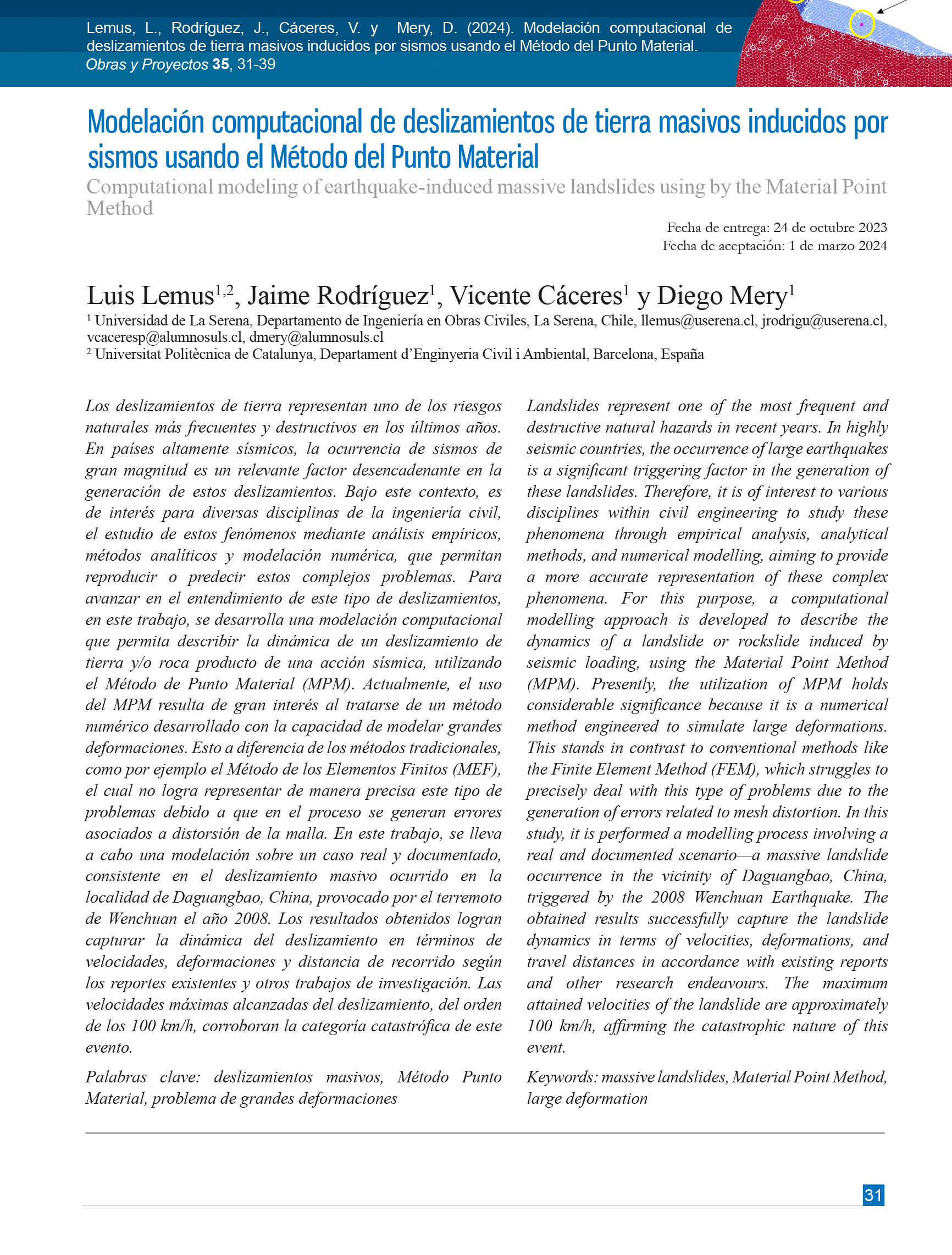Computational modeling of earthquake-induced massive landslides using by the Material Point Method
DOI:
https://doi.org/10.21703/0718-2813.2024.35.2797Keywords:
Massive landslides, Material Point Method, Large deformationAbstract
Landslides represent one of the most frequent and destructive natural hazards in recent years. In highly seismic countries, the occurrence of large earthquakes is a significant triggering factor in the generation of these landslides. Therefore, it is of interest to various disciplines within civil engineering to study these phenomena through empirical analysis, analytical methods, and numerical modelling, aiming to provide a more accurate representation of these complex phenomena. For this purpose, a computational modelling approach is developed to describe the dynamics of a landslide or rockslide induced by seismic loading, using the Material Point Method (MPM). Presently, the utilization of MPM holds considerable significance because it is a numerical method engineered to simulate large deformations. This stands in contrast to conventional methods like the Finite Element Method (FEM), which struggles to precisely deal with this type of problems due to the generation of errors related to mesh distortion. In this study, it is performed a modelling process involving a real and documented scenario—a massive landslide occurrence in the vicinity of Daguangbao, China, triggered by the 2008 Wenchuan Earthquake. The obtained results successfully capture the landslide dynamics in terms of velocities, deformations, and travel distances in accordance with existing reports and other research endeavours. The maximum attained velocities of the landslide are approximately 100 km/h, affirming the catastrophic nature of this event.
References
Al-Kafaji, I.K.J. (2013). Formulation of a Dynamic Material Point Method (MPM) for Geomechanical problems. PhD thesis, Stuttgart University, Germany.
Alonso, E.E. (2021). Triggering and motion of landslides. Géotechnique 71(1), 3-59.
Alsardi, A. and Yerro, A. (2023). Coseismic site response and slope instability using periodic boundary conditions in the material point method. Journal of Rock Mechanics and Geotechnical Engineering 15(3), 641-658.
Andersen, S. and Andersen, L. (2010). Modelling of landslides with the material-point method. Computational Geosciences 14(1):137–147.
Angeli, M.G., Gasparetto, P., Menotti, R.M., Pasuto, A. and Silvano, S. (1996). A visco-plastic model for slope analysis applied to a mudslide in Cortina d’Ampezzo, Italy. Quarterly Journal of Engineering Geology and Hydrogeology 29(3), 233-240.
Beuth, L. (2012). Formulation and application of a quasistatic material point method. PhD thesis, Stuttgart University, Germany.
Jassim, I., Stolle, D. and Vermeer, P. (2013). Two-phase dynamic analysis by material point method. International Journal for Numerical and Analytical Methods in Geomechanics 37(15), 2502–2522.
Kohler, M., Stoecklin, A. and Puzrin, A.M. (2022). A MPM framework for large-deformation seismic response analysis. Canadian Geotechnical Journal 59(6), 1046-1060.
Pinyol, N.M., Alvarado, M., Alonso, E.E. and Zabala, F. (2018). Thermal effects in landslide mobility. Géotechnique 68(6), 528-545.
Prieto, A.F., Cantor, L.C. and Rodríguez, C.E. (2020). Modelo de bloque deslizante para analizar el comportamiento cinemático de deslizamientos en suelos a partir de las fuerzas resultantes de un modelo de equilibrio límite. Obras y Proyectos 27, 64-77.
Song, Y., Huang, D. and Cen, D. (2016). Numerical modelling of the 2008 Wenchuan earthquake triggered Daguangbao landslide using a velocity and displacement dependent friction law. Engineering Geology 215, 50-68.
Sulsky, D., Chen, Z. and Schreyer, H.L. (1994). A particle method for history-dependent materials. Computer Methods in Applied Mechanics and Engineering 118(1-2), 179-196.
Sulsky, D. and Schreyer, H.L. (1996). Axisymmetric form of the material point method with applications to upsetting and Taylor impact problems. Computer Methods in Applied Mechanics and Engineering 139(1-4), 409-429.
Wieckowski, Z. (2004). The material point method in large strain engineering problems. Computer Methods in Applied Mechanics and Engineering 193(39-41), 4417–4438.
Yerro, A., Alonso, E. and Pinyol, N. (2013). The Material Point Method: A promising computational tool in Geotechnics. 18th International Conference on Soil Mechanics and Geotechnical Engineering, Paris, France, 853–856.
Zabala, F. and Alonso, E.E. (2011). Progressive failure of Aznalcóllar dam using the material point method. Géotechnique 61(9), 795–808.
Zhang, Y., Zhang, J., Chen, G., Zheng, L. and Li, Y. (2015). Effects of vertical seismic force on initiation of the Daguangbao landslide induced by the 2008 Wenchuan earthquake. Soil Dynamics and Earthquake Engineering 73, 91-102.

Downloads
Published
Issue
Section
License

This work is licensed under a Creative Commons Attribution-NonCommercial 4.0 International License.







